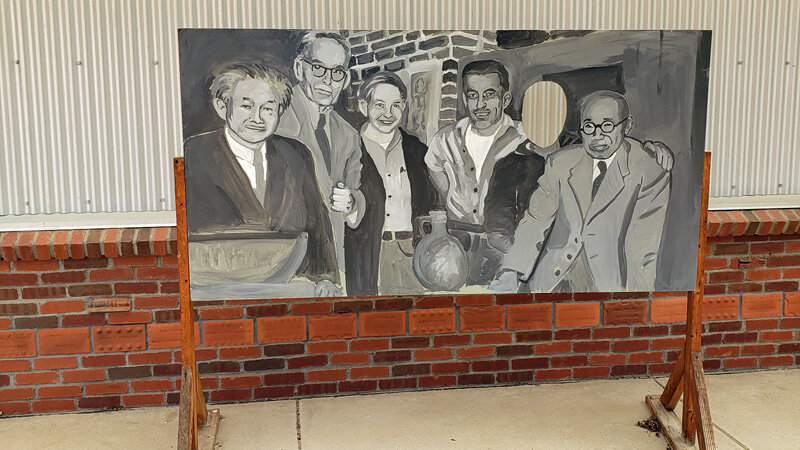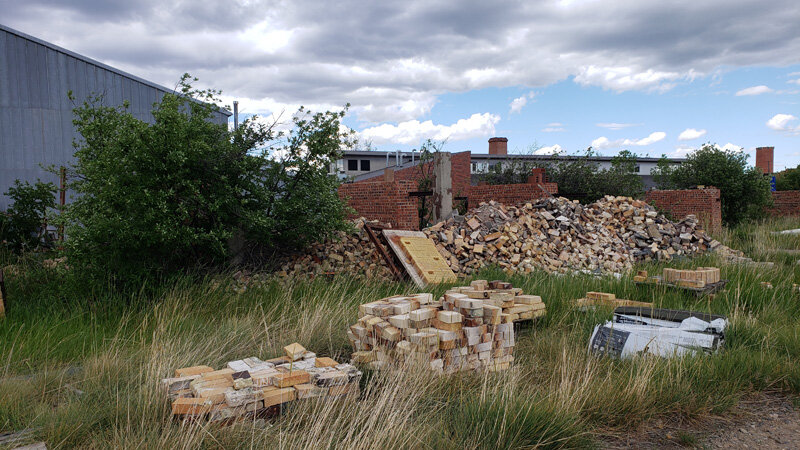The Bray
Of the 4.5 billion years of earth history that we can consult, and learn about by looking at rocks, we have the rocks for most of that time – about 4 billion years. Rocks that old are still around, they can be found & studied & chemically analyzed. Was there water? Where did it come from? Was there oxygen? (No.)
The very earliest years though of the earth existing as an object, a ball with a core, a molten mantle, a crust — the rocks that would record what life was like back then are gone probably. They wore away into sand, they got pushed under again and liquified.
Fortunately though, according to a little book I was reading called A Brief History of Earth, the information we need about the earliest years is still out there. Literally. In the form of asteroids flying around. Some of these have little aggregated bits of the rocks we need, rocks that were part of the formation materials of the solar system overall & that show the first chemistry of our planet as it came together. Sometimes the rocks come down as meteors. Geologists can go get them when they land, and cut them open, and look, in a way, at a scrapbook of the first five or so million years.
Wow, I was thinking as I read. I flipped the page over to a chart chart like a glaze recipe showing the percentage by weight (in ceramics, called a batch formula) of what makes earth these days:
Iron 33
Oxygen 31
Silicon 19
Magnesium 13
Nickel 1.9
Calcium 0.9
Aluminum 0.9
Everything else 0.3
Dad? my son said. Are we still driving to Helena today? We should probably get going.
Oh! Yes, I said.
I always do this – it's not like I don't have plenty of interesting books in my own house. I was visiting my son in Bozeman and suddenly all the books littering his apartment – many of them ARC copies obtained by his partner – seemed incredibly interesting. I just wanted to sit there reading for some reason. Yes! I said. Let's roll. I hope the Bray is still open when we get there...geez it's getting late already.
Off we went, my son driving and, like last summer, cueing new releases on Spotify for me to hear, chief among them the new Black Keys record. This sounds old, I said.
It just came out in May.
I know. Old songs though! Old blues forms. Sounds also like it’s a live session, like they’re just playing. I was taking pictures of the Gallatin from the passenger’s side, the Madison, the Jefferson, we cruised through Three Forks where these rivers join to form the Missouri. A vast, empty, sun-washed landscape – perfect place for a sci fi movie about visiting a new-formed planet.
The parking lot of the Archie Bray Center for the ceramic Arts is remarkably normal, I was thinking as we parked, hastily putting my shoes on & feeling butterflies, nervous excitement, the usual gravel and low signs with arrows toward the gallery, the studios, the store. I felt a little intimidated. The famous Archie Bray! Great potters have worked here. Potters we still talk about all the time…they started this place.
We walked casually in, donning masks, one of us reading glasses too, stopping in the foyer before an array of paper squares tacked to the wall with the names and bios of the current residents. My son and I stood together studying. When nervous or self-conscious in a public place always scan the walls for something you can read! Look Dad, someone from New Mexico, my son said.
Oh. Uh...yes that's right. Wait – I know them! We were in a workshop together...like fifteen years ago. Let me see...is their number still in my phone? That would be so crazy.
It was. I sent a text. Hey! I said. This is crazy but...
I'm over in the Summer Studio, was the brisk response. Just knock on the door & someone will let you in.
Blinking in the sun, removing masks & donning sunglasses, we started rambling around the Bray, the stacks of bricks, the old beehive kilns, the ragged Rocky Mountains rising in the far distance. It took us about four hours to tour around & talk, looking at work in the exhibition space, meeting a few other residents, starting to relax a bit.
The place felt pretty familiar actually – the gas meters, the kiln shelves stacked on edge, the work for sale on wooden sawhorses, the Laguna clay boxes, the metal shelving, the clay-reclaim garbage cans & the old wood pallets. The junk piles way out back getting overtaken by vigorous Montana grass.
The Bray is sprawling, grassy, old and new, under a big sky. My son loved how there are pots & sculpture pieces littered everywhere – lots of twisted failed pieces strewn around out by the wood kiln. Yes I said – those are cool. I should start just putting work out on the ground around my place, I said. I've got the room now.
You should have your work up here too Dad. It would fit right in.
Oh! Uh, well, gee, I don't know. These people are...you know. They're young good artists. They have ideas, I said, kicking the gravel as we walked back to the Summer Studio, a big unheated space, a great old warehouse, habitable into October apparently. Me – I said — I'm just working.
I looked at the couch in the middle of the Summer Studio as we walked past – actually it faces a woodstove so the place isn't totally unheated – a tied-off bag of pistachios on the end table. And potato chips. Probably I’m working too much, I added. I want get back to working the way people probably work here, making pieces just to try things. I used to do that more! I used to try things. You spend years gaining experience, then you reach a tipping point, that must be where I’m at now, you want to get back to the beginning. You want to encounter your own prehistory again, the time before you were on record, like those five hundred million years when rocks were created and lived out their lives totally unnoticed, doing what they do as rocks then vanishing without a way of anybody discovering what they were like. How many pots get to do that – how many days in the studio are like that? There should be a lot. Probably the Bray makes it so that there are more, on average.
We drove back to Bozeman in the setting sun. I thumbed through the history of earth book again.
After the chart showing the composition of the earth there is one showing the material makeup of a human body:
Oxygen 65
Carbon18
Hydrogen 10
Nitrogen 3
Calcium 1.5
Phosphorous 1
Everything else 1.5
A few days later, back in Santa Fe, I wake from a dream: a man is delightedly showing me three vases, they are dark stoneware, the first one is off-center, thick, with a finger trailed through wet white slip. It is flattened, squeezed together to be more oval than round. Another is almost shaggy, its form a rising opening V, craggy like layers of shale. The man in the dream is eager for my opinion. Hoping I can demure I pick up the first one and feel its weight — it is substantial, almost rock-like. I am inspired and also a bit envious.
As I sit pondering this dream my son texts one more new release on Spotify. It's the Car Seat Headrest EP, I know, everybody is totally panning this, I am inclined to be generous though. Just think about those song choices – just ponder. They are old, they are forms and icons, the band is exploring history. The band is old now...it is reaching back, less about ideas now & more channeling influences.
Those potters who are not gifted with ideas are gifted with form – with a sense of history, a yearning to recover and invoke what went before. Clay is good for that. I close my journal. Now it is midsummer, time to resume work, maybe I'll start by making three jars. This particular day as I write & then finish writing is wide-open and I can, should I choose, work just to work, try new things, stay off the record and get back to the beginning. I can throw those jars...
Like before though, like always, when I have a good clear day to work alone with something important I could do I put my feet up and reach for the nearest book.











